Reconnaissance of the emerald mines of Muzo, department of Boyacá
DOI:
https://doi.org/10.32685/0120-1425/bolgeol7.1-3.1959.410Keywords:
Beryl, beryllium , deposits, mineralizationLicense
Copyright (c) 1959 Servicio Geológico Colombiano

This work is licensed under a Creative Commons Attribution 4.0 International License.
Downloads
How to Cite
Issue
Section
Published
Abstract
The Muzo emerald mines are located 105 kilometers north and 8 kilometers west of the meridian of Bogota (Colombia), within the boundaries established by Decree 400 of 1899, in the Vasquez Territory, the western part of the department of Boyacá.
This report aims to advocate for research in the sense of developing and elaborating a sufficient prospection that serves to achieve the knowledge of the emerald deposit.
The most prominent geological structures are the Muzo and Coscuez horst, the Itoco and Pazurcha anticlines, which turn into the Terri syncline, and the Minero River Fault, considered a Trench.
The possible origins of emeralds are 1) pegmatitic solutions; 2) solutions from ultra-metamorphism (anatexis); 3) pneumatolytic-metasomatic solutions.
The refractive index varies from 1564 to 1598; this variation could be used to determine the paragenesis of the mineralization.
The Muzo mines consist of a series of black pyritic clays folded in different amplitudes of drag folds, which show several fissures filled mainly with crystalline to white calcite. These fissures result from compressional and torsional forces that took place during the formation of the Muzo and Coscuez horst, which is laterally bounded by approximately south-north normal faults in contact with the middle and upper Albian. The presence of calcite in the mentioned fissures seems to be of secondary replacement; beryl (emeralds and morrallas) is a primary mineral that is included within calcite and in druses. The thickness of calcite fissures varies from less than 1 millimeter to about 40 centimeters. However, emeralds are found in fissures 2 to 10 centimeters wide, sometimes filled with calcite. The volume of fissures within the mass of pyritic black clays can reach up to 10%, but their occurrence is not completely regular. The number of emeralds within the fissures is less than 1 %. The size of the emeralds is very variable, and some up to one pound in weight have been found.
Attention is drawn to the possibility of treating the Muzo tailings by flotation, following assays, to recover possible beryl microcrystals.
The current uses of beryllium (Be) and beryl are also mentioned. Finally, certain considerations are given for prospecting beryl in the Muzo and Coscuez area, and several recommendations are made.
The report contains three illustrative plates.
References
BERNAUER, F., 1933. -- Las llamadas maclas múltiples de esmeraldas de Muzo y sus anomalías ópticas, Comp Est. Geol. Col., tomo I, pp. 199-221.
BÜRGL, H., 1956. - Condiciones geológicas de las minas de esmeraldas de Muzo, Boyacá, Rev. Acad. Cienc. Ex. Fis. Nat., vol. IX, Nos. 36-37, pp. 380-388.
DEL Río, A., 1945. - Exploración de unos yacimientos de cuarzo en Muzo, Comp. Est. Geol. Ofic. Col., tomo V, pp. 249-250.
HUBACH, E., 1950. - Exploración de nuevos yacimientos esmeraldíferos en Muzo, Boyacá, Serv. Geol. Nal., Inf. NO 1188, Bogotá.
OTERO G., BARRIGA, A. M., 1948. - Esmeraldas de Colombia, Banco de la República.
RAINIER, P. W., 1933. - Informe geológico de las minas de esmeraldas de Muzo, enviado al Ministerio de Hacienda (tomado del Archivo de la Oficina de Fiscalización de Salinas y Esmeraldas, por el doctor R. A. Domínguez, Bogotá).
SCHEIBE, R., 1933. - Informe geológico sobre la mina de esmeraldas de Muzo, Comp. Est. Geol. Ofic. Col., tomo I, pp. 169-198.
SINGEWALD, Q. D., 1950. - Mineral Resources of Colombia, U. S. Geol. Surv. Bull. NO 964-B.
WOKITTEL, R., 1954. - Yacimientos esmeraldíferos en los Municipios ele Ubalá, Gachalá, Almeida, Macanal y Somondoco, Departamento de Boyacá, Serv. Geol. Nal., Inf. NO 1050.
WOKITTEL, R., 1957. - Recursos minerales en el Territorio Vásquez, Departamento de Boyacá, Serv. Geol. Nal., Inf. NO 1240.









